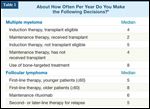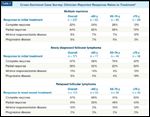Overview: Management of Treatable but Incurable Cancers
The accurate and in-depth documentation of learning gaps is a fundamental aspect of developing continuing education activities. To obtain a better understanding of community-based medical oncology practice patterns, 43 oncologists within the United States were recruited to complete a traditional clinical case–based questionnaire and to contribute specific anonymous demographic and treatment information derived from their actual patients. This information was used to create a cross-sectional case database on two types of cancer in which major clinical advances have been reported in recent years - multiple myeloma and follicular lymphoma. These diseases also are similar in that most patients experience clinically meaningful benefits from systemic treatment but are unlikely to be cured by therapy. As further described in this and the subsequent two articles, this case-based series documents that (a) clinical research advances are being quickly implemented in daily patient care and that (b) although therapeutic strategies vary based on patient age, the short-term outcomes in terms of response to and tolerance of treatment are similar in younger and older patients.
The accurate and in-depth documentation of learning gaps is a fundamental aspect of developing continuing education activities. To obtain a better understanding of community-based medical oncology practice patterns, 43 oncologists within the United States were recruited to complete a traditional clinical case–based questionnaire and to contribute specific anonymous demographic and treatment information derived from their actual patients. This information was used to create a cross-sectional case database on two types of cancer in which major clinical advances have been reported in recent years - multiple myeloma and follicular lymphoma. These diseases also are similar in that most patients experience clinically meaningful benefits from systemic treatment but are unlikely to be cured by therapy. As further described in this and the subsequent two articles, this case-based series documents that (a) clinical research advances are being quickly implemented in daily patient care and that (b) although therapeutic strategies vary based on patient age, the short-term outcomes in terms of response to and tolerance of treatment are similar in younger and older patients.
The ultimate and desired objective of continuing medical education is to improve patient outcomes. As such, the planning, development, and assessment of educational endeavors require a rigorous approach similar to those regularly used as part of scientific and therapeutic research. This process begins with and is fundamentally reliant on the accurate and in-depth documentation of learning gaps and educational need among the intended clinician audience. Historically, educational providers have mainly utilized indirect and/or subjective methods to document need, including literature reviews, analysis of learner evaluations from previous activities, focus groups, and other qualitative tactics. However, data obtained from these sources do not provide the type of quantitative evidence that truly constitutes a strong and definitive gap analysis.
To this end, there is an implied imperative for education providers to both subjectively and objectively evaluate how potential clinician learners approach decision-making and patient care and in turn assess how these treatment strategies compare with the currently available research database and published clinical guidelines. Through this type of vigorous analysis, education priorities can be established and interventions can be effectively tailored to address true need.
This report details the findings from a 2-year educational initiative designed to thoroughly define continuing education needs among practicing community-based medical oncologists and hematologists by documenting their practice patterns (both self-reported and actual) with regard to the management of multiple myeloma and follicular lymphoma.
The rationale for the selection of these two uncommon but not rare oncologic diseases stems from several factors. Notably, both multiple myeloma and follicular lymphoma are diseases for which cure is not considered a feasible treatment goal for most patients. Thus, in making therapeutic decisions for these two disorders, clinicians must commonly weigh the potential for treatment benefit vs the impact therapy may have on quality of life.
Recent Research Advances in Multiple Myeloma and Follicular Lymphoma
The recent emergence of several effective novel systemic agents has added increased complexity to the treatment algorithms for both of these diseases. In myeloma, a plethora of recent findings from clinical trials have illustrated that the use of proteasome inhibitors, specifically bortezomib, and immunomodulatory drugs (IMiDs), currently lenalidomide and thalidomide, can significantly improve outcomes for patients.[1,2] As with prior clinical research on optimizing the benefit of chemotherapy regimens, there is increasing interest in combination induction regimens that include an IMiD, bortezomib, corticosteroids, and in some cases, a cytotoxic agent. As a result, significant prolongation of survival and improved quality of life are realities for many patients.
With regard to follicular lymphoma, the previously pessimistic viewpoint-that the indolent natural history of this disease is not substantially altered by treatment-has evolved. The availability of the anti-CD20 antibody rituximab, which is currently an integral part of initial systemic management alone or combined with chemotherapy, has helped patients live longer and has raised hope that cure may one day be achievable.
TABLE 1

About How Often Per Year Do You Make the Following Decisions?
More recently, the field also witnessed the emergence of a new and improved chemotherapy option, bendamustine, which functions primarily as an alkylating agent. At the December 2009 American Society of Hematology (ASH) meeting, the presentation of a German study demonstrating better tolerability and improved efficacy with this agent in combination with rituximab compared with the current standard, R-CHOP (rituximab plus cyclophosphamide, doxorubicin HCl, vincristine, and prednisone), was an important clinical research contribution to the field.[3] Subsequently, another advance in the field was reported at the June 2010 American Society of Clinical Oncology meeting: the first report from the PRIMA (Primary RItuximab and MAintenance) trial, which demonstrated an improvement in progression-free survival with 2 years of rituximab maintenance following induction with R-CHOP, R-CVP (rituximab plus cyclophosphamide, vincristine, and prednisone), or R-FCM (rituximab plus fludarabine, cyclophosphamide, and mitoxantrone).[4]
Despite the importance of these advances, as is the case across medicine, it is not widely appreciated how practicing clinicians interpret and integrate these data, and other factors, into their management approaches and how the resultant changes in management affect patient outcomes.
The Cross-Sectional Case Survey: Real-World Therapeutic Experiences
TABLE 2

Cross-Sectional Case Survey of 595 Unselected Consecutive Patients
To obtain an assessment of community-based oncology/hematology practice, our education group recruited 43 oncologists and hematologists practicing in the United States who had previously participated in one or more of our CME programs to both complete a traditional case-based questionnaire and contribute specific information from their current patients to create a cross-sectional case database.
Specifically, these physicians were asked to complete a 60-question survey designed to identify their recent experience with myeloma and follicular lymphoma management decisions and to define their self-described treatment patterns and overall approaches to these diseases.
Responses provided during this survey indicate that these physicians are regularly engaging in treatment decision-making related to multiple myeloma and follicular lymphoma (Table 1).
Each physician was also provided access to a web-based data collection tool and asked to provide anonymous information on demographic data (gender, age, etc), presenting symptoms, diagnostic workup, treatment selection, side effects, and clinical antitumor response on patients who met two specific clinical criteria: (1) they received treatment for multiple myeloma or follicular lymphoma, and (2) their disease had been first diagnosed after January 1, 2008, or they were treated for relapsed follicular lymphoma in that same time period. Because the purpose of this educational needs assessment was to obtain information on practice patterns in a timely manner, the database was not set up as a formal treatment registry. Instead, the case variables collected were more intuitive and informal than in formal clinical research databases.
TABLE 3

Cross-Sectional Case Survey: Clinician-Reported Response Rates to Treatment
Participants were encouraged to enter all patients in their practices who met these criteria, and a modest per-patient honorarium was provided for this work. In a 3-month period, data on almost 600 patients were obtained (Table 2).
Select findings from this endeavor were recently reported at the annual ASH meeting,[5,6] and a more complete data set is unveiled here. The subsequent two articles in this supplement to ONCOLOGY detail specific findings relative to multiple myeloma and follicular lymphoma, respectively; however, a number of findings are applicable across tumor lines and are discussed here.
One of the key variables that emerged throughout this project was patient age (Figure). Although the age-related incidence of these neoplasms is well documented, the actual distribution in this population revealed that about a quarter of patients were older than age 75, an age group that has been referred to in the medical literature as the “very elderly.”[7] Our evaluation of this information included subset analysis by age group and yielded several important observations.
FIGURE

Cross-Sectional Case Survey: Age Distribution of Patients
For every case, regardless of clinical situation (induction treatment of multiple myeloma/follicular lymphoma or management of relapsed follicular lymphoma), one of the variables required to be entered into the database was overall assessment of short-term tumor response without documentation of how this was determined. The response rates (Table 3) for patients being treated initially for these two diseases demonstrated that most patients experienced objective tumor response to treatment, and within the broad parameters of this exercise, there were no major differences in outcome based on age. These findings reinforce the concept of these diseases being very treatable entities with favorable risk-benefit profiles in both older and younger patients.
Conclusion
The subsequent two articles in this supplement review these findings in more detail and compare, from a macro perspective, the outcomes observed in comparison to what has been previously reported in clinical trials. As is usually the case in this type of education endeavor, the data lead to many new questions that might be addressed in future studies. But overall, the findings provide an encouraging clue that the results of important oncology trials are being successfully replicated in clinical practice and that the various online, print, audio, and live meeting sources of continuing information/education are globally effective in allowing most patients in community-based practice to have access to state-of-the-art oncologic care.
References:
References
1. Rajkumar SV, Jacobus S, Callander NS, et al. Lenalidomide plus high-dose dexamethasone versus lenalidomide plus low-dose dexamethasone as initial therapy for newly diagnosed multiple myeloma: An open-label randomised controlled trial. Lancet Oncol. 2010;11(1):29-37.
2. Richardson PG, Weller E, Lonial S, et al. Lenalidomide, bortezomib, and dexamethasone combination therapy in patients with newly diagnosed multiple myeloma. Blood. 2010;116(5):679-86.
3. Rummel MJ, Niederle N, Maschmeyer G, et al. Bendamustine plus rituximab is superior in respect of progression free survival and CR rate when compared to CHOP plus rituximab as ï¬rst-line treatment of patients with advanced follicular, indolent, and mantle cell lymphomas: Final results of a randomized Phase III study of the StiL (Study Group Indolent Lymphomas, Germany). Proc ASH. 2009:Abstract 405.
4. Salles GA J. Seymour JF, Feugier P, et al. Rituximab maintenance for 2 years in patients with untreated high tumor burden follicular lymphoma after response to immunochemotherapy. J Clin Oncol. 2010; 28 Suppl 15s:Abstract 8004.
5. Love N, Lonial S, Anderson KC, et al. Tolerance and response to initial systemic therapy in older patients with multiple myeloma (MM): Observations from 276 unselected recent cases in the practices of US-based medical oncologists (MOs). Proc ASH. 2010:Abstract 32167.
6. Love N, Gregory SA, Cheson BD, et al. Tolerance and response to initial systemic therapy in older patients with follicular lymphoma (FL): Observations from 186 unselected recent cases in the practices of US-based medical oncologists (MOs). Proc ASH. 2010:Abstract 33658.
7. Hulin C, Facon T, Rodon P, et al. Efficacy of melphalan and prednisone plus thalidomide in patients older than 75 years with newly diagnosed multiple myeloma: IFM 01/01 trial. J Clin Oncol. 2009;27(22):3664-70.
Newsletter
Stay up to date on recent advances in the multidisciplinary approach to cancer.
Highlighting Insights From the Marginal Zone Lymphoma Workshop
Clinicians outline the significance of the MZL Workshop, where a gathering of international experts in the field discussed updates in the disease state.